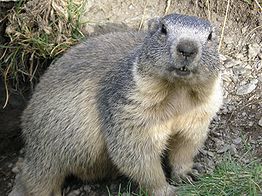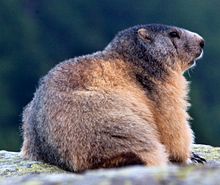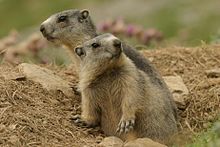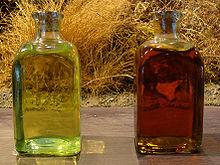- Alpine marmot
-
Alpine Marmot 
An Alpine marmot in the regional park of the Queyras in France Conservation status Scientific classification Kingdom: Animalia Phylum: Chordata Class: Mammalia Order: Rodentia Family: Sciuridae Genus: Marmota Species: M. marmota Binomial name Marmota marmota
(Linnaeus, 1758)The Alpine Marmot (Marmota marmota) is a species of marmot found in mountainous areas of central and southern Europe. Alpine marmots live at heights between 800 and 3,200 metres in the Alps, Carpathians, Tatras, the Pyrenees and Northern Apennines in Italy. They were reintroduced with success in the Pyrenees in 1948, where the alpine marmot had disappeared at end of the Pleistocene epoch.[2] They are excellent diggers, able to penetrate soil that even a pickaxe would have difficulty with, and spend up to nine months per year in hibernation.[3]
Contents
Description
An adult alpine marmot may weigh between 4 and 8 kg, stand at 18 cm at the shoulder, and reach between 42–54 cm in length (not including the tail, which measures between 13–16 cm on average). This makes the alpine marmot the largest squirrel species. Its coat is a mixture of blonde, reddish and dark gray fur. While most of the alpine marmot's fingers have claws, its thumbs have nails.
Range and ecology
As its name suggests, the alpine marmot ranges throughout the European Alps, ranging through Spain, France, Italy, Switzerland, Germany and Austria. They have also been introduced elsewhere with sub-populations in the Pyrenees, Massif Central, Jura, Vosges, Black Forest, Apennine Mountains, High Tatras, and Romanian Carpathians. Marmots are abundant in their core population; in the Romanian Carpathians, for example, the population is estimated at 1,500 individuals.[1] Alpine marmots prefer alpine meadows and high-altitude pastures and colonies, where they live in deep burrow systems situated in alluvial soil or rocky areas.[4]
Diet
Alpine marmots eat plants such as grasses and herbs, as well as grain, insects, spiders and worms. They prefer young and tender plants over any other kind, and hold food in their forepaws while eating. They mainly emerge from their burrows to engage in feeding during the morning and afternoon, as they are not well suited to heat, which may result in them not feeding at all on very warm days. When the weather is suitable, they will consume large amounts of food in order to create a layer of fat on their body, enabling them to survive their long hibernation period.[3]
Lifestyle
When creating a burrow, they use both their forepaws and hind feet to assist in the work—the forepaws scrape away the soil, which is then pushed out of the way by the hind feet. If there are any stones in the way, the alpine marmot will remove them with its teeth provided that the stones aren't too large. "Living areas" are created at the end of a burrow, and are often lined with dried hay, grass and plant stems. Any other burrow tunnels that go nowhere are used as toilet areas. Once burrows have been completed, they only host one family, but are often enlarged by the next generation, sometimes creating very complex burrows over time. Each alpine marmot will live in a group that consists of several burrows, and which has a dominant breeding pair. Alpine marmots are very defensive against intruders, and will warn them off using intimidating behavior, such as beating of the tail and chattering of the teeth, and by marking their territory with their scent. One can often see an alpine marmot "standing" while they keep a look-out for potential predators or other dangers. If one is spotted, they will emit a loud whistle or chirp—one whistle is given for possible airborne predators, more for ground predators.[3]
The mating season for alpine marmots occurs in the spring, right after their hibernation period comes to a close, which gives their offspring the highest possible chance of surviving the coming winter. Alpine marmots are able to breed once they reach an age of two years. Dominant females tend to suppress reproduction of subordinates by being antagonistic towards them while they are pregnant while causes stress and kills the young.[5] Once the female is pregnant, she will take bedding materials (such as grass) into the burrow for when she gives birth after a gestation period of 33–34 days. Each litter consists of between one to seven babies, though this number is usually three. The babies are born blind and will grow dark fur within several days. The weaning period takes a further forty days, during which time the mother will leave the young in the burrow while she searches for food. After this period, the offspring will come out of the burrow and search for solid food themselves. Their fur becomes the same colour as other alpine marmots by the end of the summer, and after two years they will have reached their full size. If kept in captivity, alpine marmots can live up to 15–18 years.[3]
Hibernation
As the summer begins to end, alpine marmots will gather old stems in their burrows in order to serve as bedding for their impending hibernation, which can start as early as October. They seal the burrow with a combination of earth and their own faeces. Once winter arrives, alpine marmots will huddle next to each other and begin hibernation, a process which lowers their heart rate to five beats per minute and breathing to 1–3 breaths per minute, which uses up their stored fat supplies as slowly as possible. Body temperature will drop to almost the same as the air around them, although heart rate and breathing will speed up if the environment approaches freezing point. Some alpine marmots will starve to death due to their layer of fat running out; this is most likely to happen in younger alpine marmots.[3]
Interaction with humans
Although not currently in any danger of extinction, alpine marmots used to be widely hunted due to the belief that their fat would ease rheumatism when rubbed on the skin. However, hunting of the alpine marmot still occurs for sport purposes. This is a danger to the species, as they are relatively slow at breeding.[3] Certain sub-populations of marmot may be threatened such as the those in the Jura and in Germany.[1] There is a population in Rodna that is very small and threatened by poaching.[6]
References
- ^ a b c Herrero, J., Zima, J. & Coroiu, I. (2008). Marmota marmota. In: IUCN 2008. IUCN Red List of Threatened Species. Downloaded on 6 January 2009.
- ^ J. Herrero, J. Canut, D. Garcia-Ferre, R. Garcia Gonzalez & R. Hidalgo (1992). "The alpine marmot (Marmota marmota L.) in the Spanish Pyrenees" (PDF). Zeitschrift für Säugetierkunde 57 (4): 211–215. http://www.ipe.csic.es/conservacion/documentos/ricardo/pdfs%20Ricardo%20Internet%20para%20Adela/28_distr_mam.pdf.
- ^ a b c d e f Wildlife Fact File. IMP Publishing Ltd. 1994. Group 1, Card 146. ISBN 08-50-04-0016.
- ^ Preleuthner, M. 1999. Marmota marmota. In: A.J. Mitchell-Jones, G. Amori, W. Bogdanowicz, B. Kryštufek, P. J. H. Reijnders, F. Spitzenberger, M. Stubbe, J. B. M. Thissen, V. Vohralík, and J. Zima (eds), The Atlas of European Mammals, Academic Press, London, UK.
- ^ Klaus Hackländera, Erich Möstlb and Walter Arnold. (2003) "Reproductive suppression in female Alpine marmots, Marmota marmota" Animal Behaviour 65(6):1133-1140.
- ^ Popescu, A. and Murariu, D. 2001. Fauna Romaniei. Academia Romana.
External links
 Media related to Marmota marmota at Wikimedia Commons
Media related to Marmota marmota at Wikimedia Commons
Photo gallery
Categories:- IUCN Red List least concern species
- Marmots
- Mammals of Europe
- Mammals of Italy
- Fauna of Italy
- Animals described in 1758
Wikimedia Foundation. 2010.






